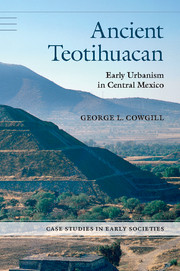Book contents
- Frontmatter
- Contents
- Lists of Figures
- List of Tables
- List of Boxes
- Acknowledgments
- 1 Preliminaries
- 2 Situating Teotihuacan
- 3 Urbanism Begins in Central Mexico: 500–100 BCE
- 4 Teotihuacan Takes Off: 100–1 BCE
- 5 Teotihuacan Supremacy in the Basin of Mexico: 1–100 CE
- 6 Great Pyramids and Early Grandeur: 100–250 CE
- 7 Teotihuacan at Its Height: 250–550 CE
- 8 Teotihuacan Ideation and Religion: Imagery, Meanings, and Uses
- 9 “Interesting Times”: Teotihuacan Comes Apart and a New Story Begins: 550 CE and After
- 10 Teotihuacan in a Wider Perspective
- Notes
- Glossary
- Bibliography
- Index
1 - Preliminaries
Published online by Cambridge University Press: 05 May 2015
- Frontmatter
- Contents
- Lists of Figures
- List of Tables
- List of Boxes
- Acknowledgments
- 1 Preliminaries
- 2 Situating Teotihuacan
- 3 Urbanism Begins in Central Mexico: 500–100 BCE
- 4 Teotihuacan Takes Off: 100–1 BCE
- 5 Teotihuacan Supremacy in the Basin of Mexico: 1–100 CE
- 6 Great Pyramids and Early Grandeur: 100–250 CE
- 7 Teotihuacan at Its Height: 250–550 CE
- 8 Teotihuacan Ideation and Religion: Imagery, Meanings, and Uses
- 9 “Interesting Times”: Teotihuacan Comes Apart and a New Story Begins: 550 CE and After
- 10 Teotihuacan in a Wider Perspective
- Notes
- Glossary
- Bibliography
- Index
Summary
Most English speakers have heard of the Aztec and Maya of Mexico and Central America and the Inka of South America, but other spectacular New World civilizations are less widely known. The ruins of Teotihuacan (Figure 1.1) are only forty-five kilometers (twenty-eight miles) from downtown Mexico City, and its immense pyramids are visited by hundreds of thousands every year, yet the distinctive nature of the culture that produced these monuments is often not recognized. Some tour guides say the city was built by the Aztecs, but their empire was a late development of the 1400s, resting on a long earlier tradition created by Teotihuacanos, Toltecs, and others. Tourists rarely see more than the restored central district of the city, and are given no idea of the vast extent of unexcavated surrounding ruins, most of which are today only gentle undulations in a surface largely covered by vegetation or, increasingly, by modern settlements.
Teotihuacan flourished in the highlands of Central Mexico between about 150/50 BCE and 550/650 CE. For much of this time, the city's population approached a hundred thousand, and in those days it was the largest city in the western hemisphere, with scores of great pyramids, richly frescoed elite dwellings, and thousands of residential compounds for the masses. It was more widely influential than any other civilization of its time in Mesoamerica – the region of politically complex societies that developed in the southern two-thirds of present-day Mexico and in northern Central America. Teotihuacan interacted with other Mesoamerican societies as far away as the Maya of Guatemala and Yucatán, some 1,100 km (700 miles) to the east (Figure 1.2). Their culture shared some general features with Teotihuacan but was quite distinct in language, political systems, and styles.
In this book Itry to distill what I have learned from 50 years' study of the great ancient city. But the literature on Teotihuacan is so vast that, in order to ever finish, Icould not read everything important ever written about the city.
- Type
- Chapter
- Information
- Ancient TeotihuacanEarly Urbanism in Central Mexico, pp. 1 - 26Publisher: Cambridge University PressPrint publication year: 2015

